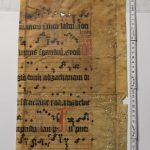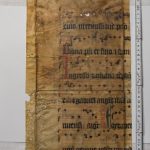Maculatura: RMK I, 122=RMNy 374: Miklós Telegdi: Az evangéliumoknac, melyeket vasárnapokon… prédicálni szoktanac elseo resze… Vienna 1577., ff 2, cf S. Fr. l. m. 97; 3 fragmentula membr.
This exciting pair of fragments from the Pauline Library originates from a 15th century Pauline Vesperal. Both fragments cover printed issues originally belonging to the Jesuits of Pozsony (today Bratislava). The host volumes may have come to Buda, to the collection of the University Library at the times of the abolition of orders, then to Pest, to the Central Seminary Library.
More to the analysis of the carriers, their possessors, and the maculature removed from the bindings, see Edit Madas, „Beiträge zur Provenienz einer Fragmentengruppe der Bibliothek des Zentralseminars
zu Budapest”, Ars Hungarica, 17(1989), 47-50.
The researcher may feel in a special situation working with these findings, as the content of the fragments can be compared to the analogous parts of the Pauline antiphoner of Remete (HR-Zmk MR8), close to Zagreb. This comparison allows us to reconsider the degree of variation of the Pauline chant melodies within the order. It is a pity that this kind of analysis is rarely possible due to the hiatuses of the Pauline sources.
The Pauline provenance of the Fr. l. m. 97 (F685) can be supported above all by an interesting argument regarding the content. The feast Spinea corona (May 4) in Hungary can solely be traced in the liturgy of the religious orders, it is not preserved in the main tradition of Esztergom. In addition to the Dominicans, the Pauline order also celebrated this feast: they used an office written to the model of St Dominic’s office. It is unfortunate that the fragment doesn’t contain the Matins, as only the Lauds and the Vespers are included in the codex of Remete with music notation, in the other hours, only the text appears. This means that the melodies of the Spinea corona’s Matins in the Pauline tradition did not survive. So, the only proprium chant in the fragment – the Magnificat antiphon – can be used to study.
Although the Paulines follow the tradition of Esztergom at almost every important point, the fragment shows us a defining peculiarity with the feast of the Spinea Corona, which clearly separates the two uses: the Pauline version and the Esztergom diocesan variants. The Magnificat antiphon Gaude felix mater ecclesia is the final piece of the first Vespers on the fragment, which note by note concurs with the melody of the Remete antiphonal located at the same position.
Previous to these, the chants for the feast of Inventio Crucis (May 3) can be found from the second Vespers. An interesting difference in the way of providing information can be discovered amongst the two sources. The fragment’s variant is more thorough, as it notates the Laud’s antiphon cycle for the Vespers fully, its last two chants are visible on the extant part of the Vespers (a4 Orabat Iudas Deus, a5 Cum orasset Iudas). This is the second Vespers and not the Lauds, because the responsory follows immediately after the antiphons: Per tuam Crucem salva nos is also a proper chant in the Esztergom tradition in the second Vespers of the feast. (In the first Vespers the responsory Tuam Crucem adoramus is given, see Andrea Kovács (ed.), Corpus Antiphonalium Officii Ecclesiarum Centralis Europae V/B Esztergom/Strigonium Sanctorale, MTA ZTI, Budapest, 2006, 63–64).) The doxology of the responsory and the assignation of the second Vespers’ Magnificat antiphon appear on the verso.
What can be seen in the Remete antiphoner at the same position? The material of the second Vespers, except for the Magnificat antiphon, is not notated here. A rubric guides the reader: the antiphons and psalms, also the hymn and the versicle must be repetead from the Lauds. The Remete source denotes the Vespers-responsory with its incipit, but erroneously with V marking. In spite of the source has fully notated the antiphons and responsory, it does not provide any information in regard of the hymn and versicle. Overall, the way of the two instructions are communicated could not be more different, even though it is exactly the same series of chants in both cases. The reason of this difference lies in the types of the books: our fragment derives from a Vesperal, hence the Lauds’ antiphons, which are repeated in the Vespers, are not prescribed.
Fortunately, the content of the other fragment of the Vesperal (Fr. l. m. 103, F691) is also informative. The Dominican relation appears here again: before the chants of John the Baptist’s office, a part of the antiphon Transit pauper ad regni solium commemorating Translatio Dominici (May 24) can be found. Assumedly, its function could be a canticle antiphon of the Vespers, though at the end of the chant, Magnificat is not indicated, only the difference of the psalm (evovae) is visible. The MR 8 gives a somewhat different assignation on the feast of St Dominic: the same antiphon is placed on the main feast, 5th of August, as the final antiphon of the first Vespers. Nevertheless, the Dominic-historia is included in the Pauline codex of Remete esentially without music, only with text and empty staves, except the canticle antiphon, where the note signs are also inscribed above the text.
László Dobszay associated the appearance of this historia in the Remete codex with its proximity to Zagreb (L. Dobszay, Corpus antiphonarum. Európai örökség és hazai átalakítás / European Heritage and Hungarian Transformation, Budapest, Balassi, 2003, 129), where the local liturgy was strongly influenced by the Dominican use at the beginning of the 14th century. We may not be satisfied with this explanation, hence the picture is quite contradictory. The fragment is that which inform us about the celebration of the Translatio feast, not the Remete codex. There is not a single chant, which can refer to the Translation day in the latter: right before the feast of John the Baptist, the chants of St Helen’s office (May 22) are performed. In spite of this fact, the celebration of the Translation is obvious, for it is part of the Pauline calendar, but in this case, we can imagine the celebration with only commune chants, at least in the Remete antiphoner, in which there is no sign of proper chants for commemoration. From all this we can conclude that the Pauline introduction of the feasts of Dominic is supposedly not related to Zagreb, but to a more general Pauline practice. Most likely, the common monastic rule emerges in the background. As a canon, St Dominic followed the rule of St Augustine, as did the Paulines and Premonstratensians, and there can not be detected a tangible connection with Zagreb. It is still a question, how the main feast of Dominic was included in the former mother codex of the fragments. Whether it was celebrated by similar opulence is unfortunately not known in the absence of surviving part that testifies.
As for the chants of John the Baptist, the Vespers beginning in the recto and extending to the verso: the end of the responsory with the doxology and the Magnificat antiphon are there. After that, however, it is not the Matins that follows, but immediately the second Vespers, hence this is a Vesperal (“In secundis vesperis antiphona”), starting with the antiphon Elisabeth Zachariae, which is the first chant of Lauds.
A perfect correspondence can be seen among the Pauline melodies, they agree in almost every detail. This also applies to the most elementary, superficial variations, the distribution of the neumes or the choice of the neume forms (e.g. whether the notator uses conjunct climacus or signs building from points, and the way to bind postpuncta).
The notation of the two fragments can also be accurately placed in the chronology. A remnant of the traditional Esztergom notation is the vertical line of points in the climacus and its different combinations, even at the cost of some punctum elements (e.g. in torculus and porrectus) being smaller and detached from the neumes to fit in the staves. This detaching practice is typical to the 15th–16th century Pauline notation, and common in the Pauline sources at the end of the 15th century. From the library’s more stylized, rigidly angular notation of the Pauline gradual, at the same time, the notation of the antiphoner fragments can be distinguished by its use of drop-like punctum forms, which gives the music script a more flexible and archaic character. The stem of the clivis also ends in a rounded hairline, starting from the closing note. This form and the elongated element of the neumes (mainly in pes and clivis), moreover, the conjunct scandicus of old manner, and every linked neume combination also refer to an earlier style of Hungarian neume writing, than that of the gradual (Fr. l. m. 122, 123, 124). The conciseness of the music script also imples that this notation is rather close in time to the notation of the ten Pauline gradual fragments of the Library of the HAS (comp. H-Ba T 292, F021).
Gabriella Gilányi



